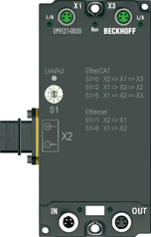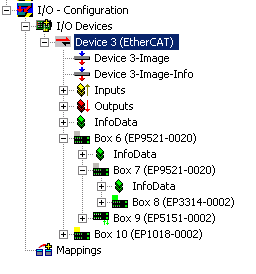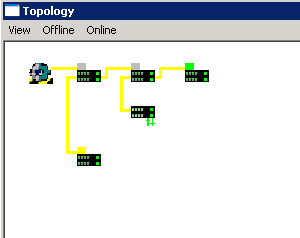Application notes
The EP9521 media converters convert physical 10/100 Mbit telegrams (FastEthernet) from copper physics (RJ45 plug) to optical fiber (LC Duplex plug) and back.
Special behavior is expected from the converter, depending on whether EtherCAT or standard Ethernet telegrams are to be transferred.
This must be selected with the rotary selection switch.
 | Rotary selection switch The communication direction and the protocol (EtherCAT or Ethernet) are selected using the rotary selection switch. This is important in order to ensure trouble-free functioning and not to interfere with other network devices. |
Used for: Standard Ethernet 10/100 Mbit
An Ethernet connection is a managed point-to-point connection between two intelligent end devices.

Both devices transmit the so-called idle pattern in their Ethernet connection. When they also receive a corresponding pattern, the connection and thus the so-called link has been established. Both devices then know that they can use this connection. If the connection is interrupted, a link no longer exists and both devices indicate this, for example, by the LEDs.

If a media converter is placed between the two stations, it too becomes an intelligent transmitter/receiver. If connection C is interrupted, device A would not necessarily be informed and would continue to send data to the converter via the existing link B, and the data would "trickle away". The EP9521 therefore supports Link Loss Forwarding (LLF) in a direction that must be selected. The message direction is selected by means of the rotary selection switch setting. Therefore, if the converter shown in Fig. Inline media converter in Ethernet link detects an interruption in connection C, it also removes the link from connection B.

In both IP settings the EP9521 operates as a store and forward network device with checksum function. Frames that are faulty (CRC error), too short (<64 bytes) or too long (>1536 bytes) are not passed on.
Used for: EtherCAT (100 Mbit)
Other characteristics are required if it is used as a media converter in an EtherCAT network:
- Consistently low delay in the frame transit, irrespective of frame length
- Fast link detection when the connection is established and interrupted
- Identification as separate EtherCAT device with diagnostic function
EtherCAT slaves process the EtherCAT telegrams in forward direction from the perspective of the master. With the EP9521 therefore, depending on the case, the transit
S1=0 X2 -> X1 -> X3
S1=2 X1 -> X3 -> X2
S1=5 X1 -> X2 -> X3
can be the forward direction. It has to be set at the rotary switch prior to commissioning. The direction of the arrow of S1 indicates the set forward direction.
Used for: Ethernet (100 Mbit)
Only ports X1 and X2 are supported in Ethernet operation.
S1=1 X2 -> X1
S1=6 X1 -> X2

Make sure the rotary selection switch is set to the right position, so that the EP9521 operates in the forward direction.
Examples
In Fig. Copper -> fiber optic -> copper - operation of two media converters, the left-hand EP9521 S1 = 5, the right-hand EP9521 S1 = 0 is to be operated as copper --> optical fiber (rotary selection switch setting 5), the right-hand is to be operated as optical fiber --> copper (rotary selection switch setting 0).
The "running direction" of the EtherCAT frame is thus:
MASTER -> X1 (EP9521_1) -> X2(EP9521_1) -> X2(EP9521_2) -> X1(EP3314) -> X3(EP5151) -> X3(EP9521_1) -> X2(EP9521_1) -> X3(EP1018) -> MASTER

The mapping in the TwinCAT System Manager takes place as follows:


If the opposite direction of rotation is set, the subsequent behavior depends on the EtherCAT master. The scanned EP9521 may be inserted at a different position in the topology, or an INIT_VPRS error message of the EtherCAT master may occur.
General notes
The EP9521 deals with setting the rotary switch when the operating voltage is applied, unless the rotary switch is in an invalid position. In this case the EP9521 accepts the setting as soon as the rotary switch reaches a valid position for the first time.
If the rotary switch is moved during valid operation, the EP9521 does not alter its function, but indicates this state through its LED, see Diagnostics. The switch setting must be rectified before the voltage is re-applied!